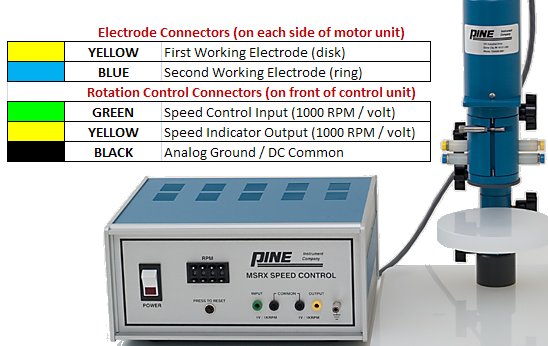The CBP bipotentiostat system offers you a choice between front panel control of the instrument or software control using our powerful AfterMath software package.
Software Control. Most customers prefer to use our AfterMath Data Organizer software to set up experiments, analyze results, and keep their data organized. AfterMath fully supports both single and dual working electrode methods. This allows you to use the bipotentiostat with rotating ring-disk electrodes, interdigitized array electrodes, sandwich electrodes, paired band electrodes, and twin-electrode thin layer cells. Of course, the bipotentiostat can also perform traditional single working electrode techniques such as cyclic voltammetry, chronoamperometry, differential pulse voltammetry, square wave voltammetry, etc.
Front Panel Control. If desired, the CBP bipotentiostat can be operated as a fully functional stand-alone analog bipotentiostat. Intuitive front panel controls permit separate and independent control of the potential of two working electrodes in the same electrochemical cell. One of the advantages of using front panel control is that it lets you use the built-in analog sweep generator to provide a true analog potential sweep to the electrodes (as opposed to the digital staircase approximation of a sweep that is used while under software control). Particular attention has been given to the design of the sweep generator and its front panel controls to give you flexible control of the sweep at any point during a particular cycle and direct control of the sweep rate and sweep limits. . The sweep may span any range within the +10 volt to -10 volt range, and sweep rates from 1 mV/sec to 1.00 V/sec are available from the front panel. Sweep limits may span a range as small as 10 mV up to a full twenty volts apart. The two limits may be set both positive, both negative, or one positive and one negative. You may halt or zero the output of the sweep or change the direction of the sweep “on-the-fly” using simple front panel controls.
Output Signals. The potential and current of each working electrode is presented on the front panel for easy connection to a third-party recording device in those cases where you do not want to record the signals under software control. Seven decades of current conversion settings are provided. These range from 100 nA/V up to 100 mA/V. A front panel voltmeter gives you instant feedback regarding all of the important front panel signal levels. In the event that an overload condition occurs during your experiment, an indicator will alert you to a possible error condition, but the bipotentiostat’s feedback circuitry will continue to function.














